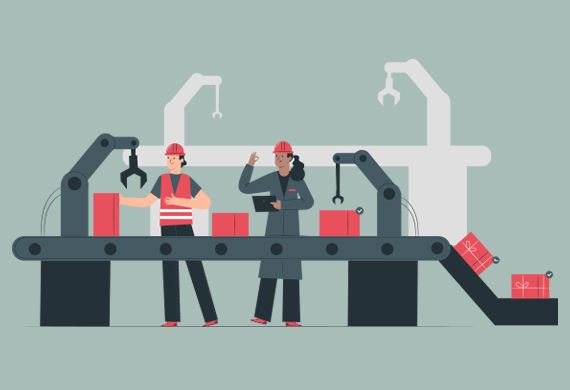
Tips to Manage Working Capital for Your Manufacturing Business
By: Neha Patel, Content Writer | Tuesday, 11 June 2024
Are you into manufacturing Business? Would you like to scale it up further? Of Course you would want to be like any ambitious entrepreneur. However managing finance can be challenging at times with changing economic conditions and seasonality. Before even thinking about expanding business you would want to make sure that the current functioning of your MSME is as per your expectations. If you struggle with the day to day running of your business from a financial point of view, you would need a collateral free business loan to support you. The manufacturing sector is very important for the growth of India as a country and hence having sufficient working does help businesses to survive the worst of the times of the market as well.
Understanding Working Capital Management
Working capital refers to the difference between a company's current assets and its current liabilities. In simpler terms, it's the readily available cash used to finance day-to-day operations. For a manufacturing business, this includes:
- Current assets: Inventory (raw materials, work-in-progress, finished goods), accounts receivable (money owed by customers), and cash.
- Current liabilities: Accounts payable (money owed to suppliers), short-term loans, and accrued expenses.
Having a balance between your assets and liabilities is needed which is healthy for your MSME business. Having sufficient working capital funds helps you in maintaining this balance. But realistically creating a balance between assets and liability is not easy and that is where an aid in the form of working capital loans can give you a temporary boost until your business could deal with immediate deficiencies due to the lack of sufficient financial balance.
Here's why working capital management is crucial for manufacturing businesses:
- Improved Cash Flow: Efficient management frees up cash for investments in new equipment, technology, or marketing initiatives, fostering growth.
- Reduced Risk of Stockouts: When there is increased demand you wouldn’t want to run out of stock. Working capital helps dealing with this as you could stock up way in advance.
- Enhanced Profitability: By minimizing carrying costs associated with excess inventory and streamlining payment collections, you improve your bottom line.
- Stronger Supplier/Vendor Relationships: Getting paid on time makes the suppliers happy and having a healthy vendor relationship always adds value to your business and in increasing trust in your business and can lead to getting better pricing for raw materials/services..
How to Manage Working Capital for Your Manufacturing Business
Here are some practical tips to effectively manage working capital in your manufacturing business:
1. Inventory Management:
- Implement Just-in-Time (JIT) Inventory: This approach minimizes the amount of raw materials stored at hand, reducing carrying costs and storage space requirements. However, it requires strong forecasting and supplier relationships to ensure timely deliveries.
- ABC Classification: Categorize inventory based on value and criticality. Focus on controlling high-value (A) and critical (B) items more tightly, while allowing for slightly more flexibility with low-value (C) items.
- Regular Inventory Analysis: Make sure you do periodic audits to identify and eliminate obsolete or slow-moving inventory. Implement lean manufacturing practices to minimize waste and to maximize production efficiency.
2. Optimize Accounts Receivable:
- Streamline Invoicing: As a growing business with aspirations you should always prioritize the invoices that are shared on time and cleared. Also consider giving discounts for clearing due payments to have healthy cash flow in your MSME.
- Implement Credit Control: Establish clear credit policies and terms. Screen potential customers before extending credit and actively follow up on overdue payments.
- Explore Alternative Payment Options: Consider offering online payment options or electronic data interchange (EDI) to accelerate the collection process.
3. Manage Accounts Payable Strategically:
- Negotiate Favorable Payment Terms: Payment terms should be negotiated and try to get an upper hand in your favor from your vendors. However, ensure this doesn't damage your ongoing relationship with main vendors.
- Take Advantage of Early Payment Discounts: This is one of the best tactics to be used if your cash flow allows it, consider finishing up payments to your suppliers at the earliest to take advantage of potential discounts and maintain a positive credit rating.
- Centralize Accounts Payable: Streamline your MSME business’s payment procedure by centralizing accounts payable functions and leveraging latest tech to automate payments.
4. Leverage Technology:
- Invest in Inventory Management Software: It will become impossible to manually calculate and keep books on the inventory availability and order, so it is recommended to invest working capital in the latest tech to automate this process for your MSME.
- Utilize Accounting Software: Having the most efficient account software will eradicate manual accounting and will avoid errors from happening. This also makes the reporting and sharing accounts info within your MSME easier as well.
- Explore Financing Options: Depending on your needs, explore options like working capital loans or invoice factoring to bridge temporary cash flow gaps.
5. Build Strong Relationships:
- Develop Partnerships with Key Suppliers: It is important to have very good networking and good relationships with the suppliers as they are often the pillars who keep the raw materials incoming if you are a manufacturing business owner. Ensure healthy working capital to pay them on time and keep the connection strong.
- Communicate Openly with Customers: Be transparent and keep an open communication especially about expected time for fulfilling orders placed. Nobody wants to keep following up with businesses for what they ordered and could turn frustrating and losing trust..
Conclusion
Managing your SMEs working capital can be difficult, but can be managed efficiently with proper process in place. You need to keep an eye on it all times for a proper balance within your business and for its growth. If needed apply for business loan at an NBFC which can be used to strengthen the working capital, which usually comes without needing collateral.
Most Viewed
- 1 Women's Health Startup HerMD Closing Doors Amid Industry Challenges
- 2 5 Famous Women in Indian Armed Forces
- 3 Saudi Women No longer Require Male Permission for Clothing Choices, says Prince MbS
- 4 Kolkata Medtech Startup Innovodigm Raises Rs 5.5 Crore Seed Funding Led by IAN Group
- 5 Yamunanagar's Kashish Kalra Honoured after Securing 111th Rank in UPSC Civil Services Exam
- 6 Madurai Appoints Its First Woman Corporation Head
- 7 IAS Vijayalakshmi Bidari Appointed as the new Nagpur Divisional Commissioner
- 8 American Entrepreneur Lucy Guo Overtakes T Swift to become Youngest Female Billionaire
- 9 ICC Women's World Cup 2025 Trophy Showcased at Indore's Holkar Stadium
- 10 Aparna Saxena's Beauty Venture AntiNorm Launches in India
- 11 Vidya Nataraj Co-Founded BlueStone Jewellery & Lifestyle files IPO
- 12 5 Women Freedom Fighters of India
- 13 Dr. G Krishnapriya appointed as CEO for Trichy
- 14 M3M & Sirona Partner to Introduce Menstrual Hygiene Vending Machines in 15 Locations
- 15 Punjab Govt launches SHE Cohort 3.0 Supporting Tech-led Women Startups
- 16 Indian origin Lawyer, Sweena Pannu appointed as the US New Superior Court Judge
- 17 The Aurora Tech Award recognizes 4 Indian Women-led Startups
- 18 Kerala's Republic Day parade featured an all-female tableau
- 19 Manisha Kabbur Becomes Karnataka's First Woman International Karate Coach
- 20 Director K. S. Ravikumar's Daughter Maalica Ravikumar Launches Life Coaching Company 'Evergrowth Academy' for Women
- 21 Leezu's Raises Pre-Seed Funding to Accelerate Growth in Sexual Wellness Industry
- 22 Sattu: Super-easy summer drink for PCOS gut healing
- 23 Swathi Nelabhatla creates Sitha App, India's First Women-Exclusive Gig Platform
- 24 7 Timeless Female Kathak Dancers & their Iconic Legacies
- 25 Meet 7 Iconic Women Architects of Modern India & their Most Impactful Work
- 26 This Woman-led Insuretech Startup is Helping Bridge the Education Financing Gap in India
- 27 Women Leaders Share Lessons Learnt from India Women's WC Win
- 28 5 Enterprising Women Founders Powering Singapore's Tech & Innovation Landscape
- 29 4 Women. 4 Stories. One Vision for Smarter, Stronger Healthcare
- 30 Global Gender Gap Narrows to 68.8%, But Full Equality 123 Years Away: WEF Report 2025
- 31 Changemakers: 7 Women Entrepreneurs Taking the Make in India Movement Forward
- 32 Meet Lucy Guo, The Youngest Self-Made Female Billionaire Disrupting Tech
- 33 How Women are Driving India's Festive Online Shopping Surge






